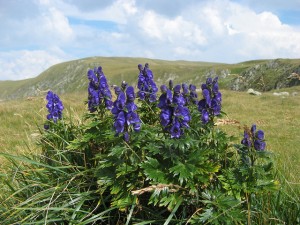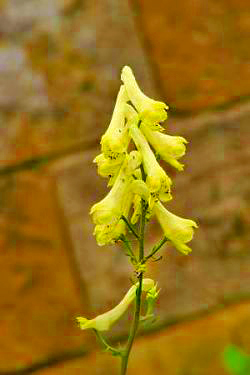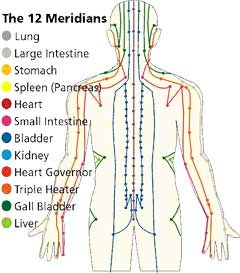Healing With Herbs: Aconite

The use of herbs is an effective way to nurture our body’s self-regulatory system and maintain a balance of energy. As mentioned in the previous blog post, Yin and Yang, every herb has a “taste” that has a certain affinity for a particular meridian, so herbs are selected based on which meridian an ailment is located in. The taste and nature of an herb determines how effective it is for treating a specific ailment. There are five tastes and four natures that we use to classify herbs. The five tastes are acrid, sweet, bitter, sour, and salty. Each taste implies certain properties and therapeutic actions of the herb. For example, sweet herbs function to tone, improve, moisten, and harmonize many important systems of the body. They act to relieve urgency and inhibit pain caused by muscle constriction. Sweet herbs are commonly used to treat conditions like dry cough and gastrointestinal dysfunction.
The four natures are hot, warm, cool, and cold. The natures refer to the intensity of yin (cold) and yang (hot) where hot/cold represents the extremes and warm/cool represents the intermediates. The natures were named based on their ability to alleviate acute heat and cold syndromes. For example, an herb that is designated as hot in nature will cause a burning sensation in the mouth and stomach when ingested. Hot herbs act to expel cold, stimulate metabolism, restore yang, and are mainly used for cold-syndrome. Conversely, cold herbs have the ability to alleviate heat-syndrome. They act to reduce a fever by clearing heat, purging fire, and eliminating toxic materials. The nature of an herb is not fixed. Traditional processing is seen as a transformative function, so when an herb is processed there is a change in its nature. Other influences that may affect an herb’s properties are their combinations in herbal formulas, the body conditions of the person consuming them, and sometimes environmental conditions when consumption occurs.
It is important to note that hot and cold qualities within an herb can coexist. Similar to yin and yang, the more extreme quality will dominate. In some cases, the two coexisting qualities will not dominate each other, but instead manifest under different circumstances. The same is true when combining tastes or combining multiple herbs in a formula. When combining multiple tastes, one taste may alleviate the extreme quality of another. For example, a sweet herb may be used to help reduce the strong sense reaction to bitter. Mixtures of herbs are often used by TCM practitioners to avoid giving a client too much of one type of energy. For example, a hot herb might be matched with a cooler herb in order to protect the yin and maintain balance.
The taste and nature of an herb are interconnected as well. In traditional literature, the flavor is considered to be the yin aspect of an herb while nature is considered to be the yang aspect. Both, flavor and nature reflect the basic essence of the herb and the type of effect it will have. An example is the perilla leaf, which is a spicy warm herb. The warm and spicy qualities of the herb work in combination with each other.
Aconite

Aconite, formally known as Aconitum, is a genus made up of more than 250 species of flowering plants that belong to the Ranunculaceae family. They are perennial plants that are native to mountainous parts of the northern hemisphere. Most of these herbaceous species are highly toxic, but if utilized properly and with caution they can be quite beneficial to one’s health. In order to use aconite for medicinal purposes, it must be properly treated before use. In TCM, aconite is used to restore depleted yang. It does so by tonifying yang and warming channels to relieve pain. Aconite acts to tonify the heart and kidney yang. When the heart yang is tonified, it unblocks blood vessels to improve circulation. Tonifying the kidney yang augments fire, which counteracts the abundant cold yin.

Aconitum lycoctonum, commonly known as wolfsbane, is one of the 250 species that belong to the genus Aconitum. It is an herbaceous perennial plant that is dark violet in color and very rarely pale yellow like shown in the image above.
Aconite is characterized as being acrid and hot. It is used to treat yang deficiencies (excess Yin) by warming all of the organs and opening all of the channels and collaterals. A Yang deficiency occurs when there is a consumption of Yang energy resulting in excess Yin. The most common symptoms of Yang deficiency involve cold and hypo-activity. Some common symptoms that characterize Yang deficiencies are profuse perspiration, cold sweats, shortness of breath, intolerance of the cold, cold extremities, diarrhea containing undigested food, and a faint pulse. Some additional symptoms may be caused by certain yang deficiencies related to the affected area. The organs most susceptible to yang deficiencies are the heart, kidneys, and spleen. It is important to note that when ingested aconite enters specifically through the channels of the heart, kidney, and spleen. Therefore, it can be concluded that the organs most susceptible to yang deficiencies are the ones that are targeted by aconite.

If you recall from the Yin and Yang article, the Chinese character for Yin represents the shady side of a hill, while the Chinese character for Yang represents the sunny side of a hill. Since aconite grows in the shade, a strong Yin environment, there must be elements of Yang present to balance the environment as a whole. The fact that aconite is cultivated in a strong Yin environment indicates that it must have strong Yang energy. The Yin-Yang theory has been around since 700 B.C., so when ancient people discovered aconite growing in the shade, they were able to hypothesize that this specific herb may help treat yang deficiencies. When the theory was tested it was found to be true and aconite has been used to treat yang deficiencies ever since.
[…] We will go into further detail about how aconite enters and passes through the channels in the next blog post. Stay tuned to learn more about using herbs obtain optimal health and […]
Very much appreciated. Thank you for this excellent article. Keep posting!